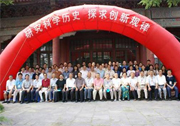| 英文摘要: |
In 1956, disciplines including nuclear technology and research on nuclear and elementary particles were added to the P. R. China’s national program for science and technology development. Mao Zedong explicitly supported Shoichi Sakata, a Japanese physicist, in applying materialistic dialectics to physics research, which influenced Chinese scientists in their study of particle physics. Starting in the early 1960s, physicists from the Institute of Atomic Energy, CAS, the Institute of Mathematics, CAS, Peking University, and University of Science and Technology of China put effort into the theoretical research of elementary particles and gradually formed a collaborative research group. From 1965 to 1966, they analyzed the experimental results and existing theories available to them, made a connection between their work and Mao Zedong’s belief that matter can be infinitely divided, and put forward the straton model, a structure model of hadrons. In July 1966, the straton model was presented at the Summer Physics Colloquium of the Peking Symposium. Unfortunately, scientific research in China soon came to a halt due to the Cultural Revolution (1966–1976); the academic exchange between Chinese scientists and their foreign peers became even more difficult than before. The calculation results of the hadron model failed to be formally published in English as Chinese scientists had wanted. As a result, the model did not have the kind of influence upon the development of particle physics at the international level that these scientists had expected. |





